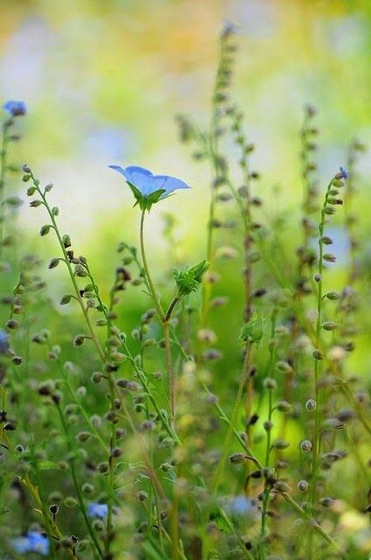Blue Flax (Linum lewisii)
Such pretty blue flowers. I could see these spread throughout a meadow or cottage garden. I don’t have a lot of blue flowers in my garden, as I tend more towards purples, but these would be a nice addition. It would also be great if I could get them to naturalize and seed. I love the ease of growing perennials in the garden. They require so much less care and return the initial effort of planting year after year.

Linum lewisii (Linum perenne var. lewisii) (Lewis flax, blue flax or prairie flax) is a perennial plant in the family Linaceae, native to western North America from Alaska south to Baja California, and from the Pacific Coast east to the Mississippi River. It grows on ridges and dry slopes, from sea level in the north up to 3000 m altitude in the south of the species’ range.
It is a slender herbaceous plant growing to 90 cm tall, with spirally arranged narrow lanceolate leaves 1–2 cm long. The flowers are pale blue or lavender to white, 1.5–3 cm diameter, with five petals. — Wikipedia.org
A 2-3 foot perennial with delicate leaves and true blue sky flowers from Mar. to Sept.. Native to middle to high elevations, Alaska to southern California. A good garden flower. Showy, every morning it covers itself with 1″ blue flowers, hundreds per day. The leaves themselves stay at 18″ or so but the flowers arise above making a total arching display 3′ or so high. Use in perennial garden, rock garden, or even in a container. In areas where the snow is on the ground until March to June this plant will flower all summer. I’ve seen it in the snow fields and in dry rocky sunny sites at 6000-8000′. In San Diego it is at about 3000 ft on a rocky south facing slope mixed with Diplacus Clevlandii and Brodiaea. It has done well within sight of the ocean and ok in the desert as long as it gets watering. This is another plant that doesn’t behave as you would think. It survived up in our garden with no water for two seasons in full sun, flowering its little heart out each morning from late March until mid-July. The reason it did not get water is the drought (11″ one year and 5″ the next) did not allow us to use any. In the garden it does need to be trimmed down each winter. – Las Pilitas Nursery
- Blue Flax (Linum lewisii) on Wikipedia
- Blue Flax (Linum lewsii) on Fine Gardening
- Blue Flax (Linum lewsii) on Aggie Horticulture
- Blue Flax at LA Pilitas Nursery
Previously in the Interesting Plant series:
- Chestnut (Castenea)
- Camellia japonica ‘Anemoniflora’
- Zaluzianskya villosa “Southern Lilac Drumsticks”
- Prickly Pear Cactus (Opuntia)
- Campanula
- Rudbeckia
- Caladium bicolor ‘White Queen’
- Fuchsia
- Palo Verde Tree (Parkinsonia florida)
- Espalier Fruit Trees
- California Poppy (Eschscholzia californica)
- Hydrangea ‘Zorro’
- Harlequin flower (Sparaxis tricolor)
- Erythronium
- Sempervivum
- Primula auricula
- Feathery Cassia (Senna auricula)
- Red Stick Dogwood (Cornus alba ‘Sibirica’)
- Japanese Maple (Acer palmatum)
- Kousa Dogwood (Cornus kousa)
- Giant Chalk Dudleya (Dudleya brittonii)
- Sunrose (Helianthemum nummularium)
- Australian/New Zealand Tea Tree (Leptospermum scoparium)
- Brugmansia Sanguinea
- Calico Monkeyflower (Mimulus pictus)
- Colocasia Esculenta
- Acer palmatum ‘Sango-kaku’ (Coral Bark Japanese Maple)
- Linderniaceae (formerly Torenia) Kuaui Deep Blue
- Passiflora (Passion flower)
- Firewheel Tree (Stenocarpus sinuatus)
- Anemone
- Allium Cowanii
- Symphyotrichum oblongifolius (Purple Aster)
- Hemerocallis ‘Derrick Cane’ (Daylily)
- Agastache ‘Aztec Rose’
- Rudbeckia hirta Moreno
- Kalanchoe Tomentosa
- Albuca namaquensis
- Hosta ‘Remember Me’
- Dahlia ‘Clair de Lune’
- Lovely silver-tinged fern on campus of Oberlin College, Ohio
- Tricolor Beech (Fagus sylvatica Purpurea Tricolor)
- Climbing Hydrangea (Hydrangea anomala petiolaris)
- Eremurus ‘Lemon Meringue’
- Lupine “Sunrise” (Lupinus hartwegii)
- Chinese Fringe Flower (Loropetalum chinense)
- Streptocarpus ‘Harlequin Blue’
- Nigella damascena (love-in-a-mist, ragged lady)
- Epiphyllum (Orchid Cactus)
- Sempervivum ‘Westerlin’
- Gladiolus ‘Kings Lynn’
- Hosta sieboldiana ‘Dorothy Benedict’
- Begonia “Escargot”
- Asparagus Pea (Psophocarpus tetragonolobus)
- Rosa banksiae (Lady Banks’ Rose)
- Primula ‘Victoriana Silver Laced Black’
- Oxalis versicolor
- Poached Egg Plant (Limnanthes douglasii)
- Parisian Carrots
- Fritillaria imperialis Rubra Maxima
- Clematis “Fascination”
- Swiss Chard “Bright Lights”
- Georgia Rattlesnake Melon
- Dianthus Barbathus “Green Ball” or “Green Trick”
- Coleus “Religious Radish”
- Black Forest Calla Lily
- Black Bamboo
Interesting Plant is a series from A Gardener’s Notebook blog and podcast that highlights the most interesting plants I find in my Internet and real-world travels — Douglas




